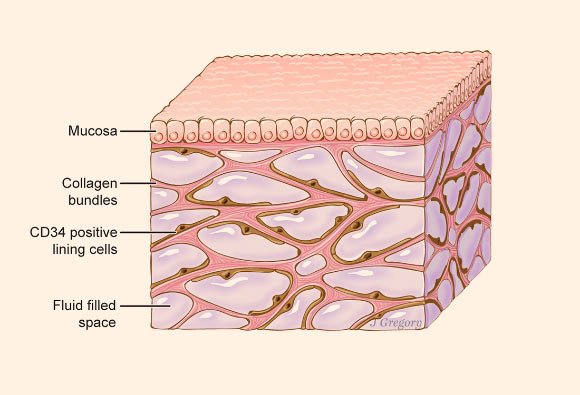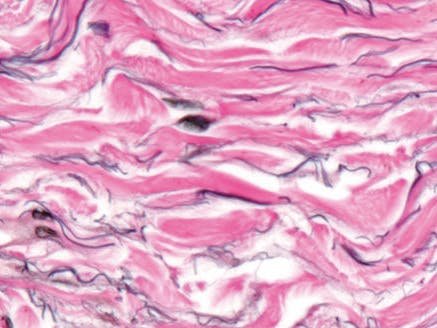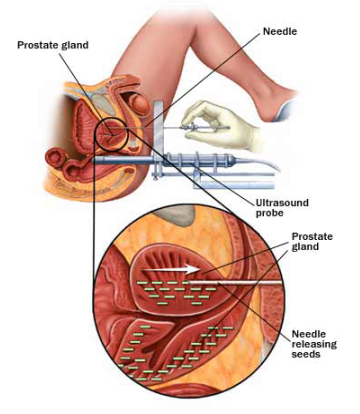Scientists recently discovered a new organ in the human body- but is ‘new’ really the correct depiction for something that has been present all along?
The human body, over time, has adapted and changed via evolutionary measures in order to better suit us for optimum survival. While the body itself hasn’t changed a whole lot in nature, the number of vital organs that our bodies indispensably relies on -- has.
On Tuesday of this week, scientists denoted their newest finding, adding to this long-standing list of vital organs present in the human body (now 80 known). This ‘new’ organ is known as the interstitium, which is essentially a vast network of fluid-transporting vessels that spans across the entirety of our complex organizational structure.

Figure above shows interstitium, fluid filled spaces supported by collagen fiber bundles
Image Source
This so-called discovery has been existent all along, so how was such a vast array of complexes missed so easily?
The controversy remains apparent due to the fact that the interstitium was previously designated as a counterfactual form of connective tissue. Previous analyses of this complex structure were misinterpreted and misidentified due to its multifarious makeup.
Organs are usually present in a systemically localized region of the body, but the interstitium, on the other hand, is unlike any other organ that we’ve looked at in depth. Scientists are now stating that the interstitium is the largest organ, by volume, in the entire human body. As previously mentioned, this organ spans throughout the entire body and can be readily described as a fluid-filled space which is supported by a framework of fibrous bundles made up of collagen.

Collagen fibers supporting fluid-filled channels which make up the interstitium
Image Source
The point I am getting to that is really interesting, however, is the fact that the interstitium runs both within other vital organs, as well as between them.
WHAT DIFFERENTIATES THE INTERSTITIUM FROM NORMAL CONNECTIVE TISSUE YOU ASK??
Connective tissue, in a broad sense, can generally be characterized as the wide-ranging tissues which support other tissues and vital organs of the body, such as our bones, blood and lipids for example. The interstitium, on the contrary, has been found to connect a more explicit type of connective tissue within a far greater and more complex over-arching system. In addition, this specifically conveys the potential for the interstitium to provide a protective layer in & around other organs of the body, as well.
The complex nature of this organ really demonstrates the reason as to why it took scientists so long to identify the existence of such a potentially protective assortment which is located throughout our bodies. Previous explorations lead to misunderstandings and simple viewing errors which consequentially resulted in the prolonging of the initial discovery from occurring much sooner than it otherwise might have.
BARRIERS TO INITIAL DISCOVERY
A problem which was permitting this particular barrier to occur was the mischaracterization of the connective tissue, which I mentioned earlier. Once it is removed from the body for further examination, all the fluid begins to slowly ooze out, which leaves a structure of solid layers as compared to fluid-filled pores and channels of the organs.
Sampling had also been another previous issue which scientists encountered along their journey of findings. In order to combat this concern, researchers came up with an innovative method of obtaining bile duct tissue samples from recently performed surgeries. This method ultimately allowed for them to capture samples without losing the unique structure of the fluid-filled vessels which make up the interstitium.
Further examination of this particular study showed that the tissues are "compressible and distensible and may thus serve as shock absorbers.” Tissues were also found to serve as a connection point to the lymphatic system- a central player in human immune response. As a fluid-filled complex, it could very well function as a crossway for proliferated cancer cells to migrate throughout the body more easily. This would be very important for cancer researchers in order to better understand how certain cancers metastasize and how to prevent it from spreading to other regions of the body.
All of this, however, is still pending and the implications of this discovery are still far from over. A lot of research still needs to be conducted pertaining to this ‘new organ,’ if it even is one for that matter. This controversial topic will be in the realm of discussion for quite some time, as only time will tell if this is actually a discovery worth noting.

Interesting re-steemed to show other people at home here
Hey, thanks I really appreciate that- the more eyes the better as far as I'm concerned.
Much respect from
@conradsuperb
Ah, how far science has brought us. Strange how something that's almost always been a part of our anatomy is just being classified as an organ, but that's still pretty cool.
Yeah, the discoveries being made are truly revolutionizing for the fields of science and medicine altogether. It's crazy to think that there is so much out there that we still don't know about, but that we will slowly, but surely come to realize as advancements continue to be made. Something like this, you would never think to be overlooked for as long as it was, but this just goes to show how much potential we have as a species to make expansive augmentations for future generations to come
thanks for stopping by- steem on & stay cashing in!!
This is why I love science! There is always something new to be discovered. Dictionary.com told me an organ is "a part of an organism that is typically self-contained and has a specific vital function, such as the heart or liver in humans. It sounds to me like interstitium fits that description. Granted, we aren't 100% sure if we're correctly guessing it's function. We'll have to wait and see!
Yeah, it sounds as though the interstitium may provide a vast array of functions which could be beneficial for us and our bodies, as a whole. The fact that it spans across, through and between all of our other vital organs that we so heavily rely on in order to maintain proper homeostatic balance tells me that we could really be onto something more here.
The topic is still up for debate, however, and controversy remains high, but it sounds as though this is a step in the right direction in terms of debunking any doubtful or questionable understandings which remain present.
only time will tell, but I think the future of this discovery remains bright!!
Steem on :)
You got a 5.54% upvote from @upmewhale courtesy of @conradsuperb!
Earn 100% earning payout by delegating SP to @upmewhale. Visit http://www.upmewhale.com for details!
Great post!
Thanks for tasting the eden!
You got a 12.84% upvote from @brupvoter courtesy of @conradsuperb!